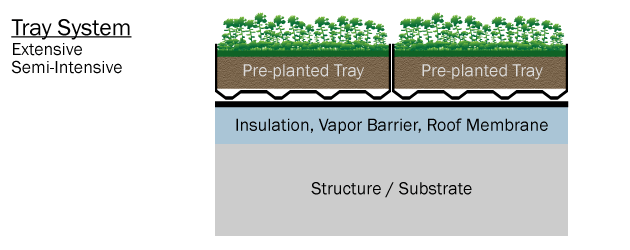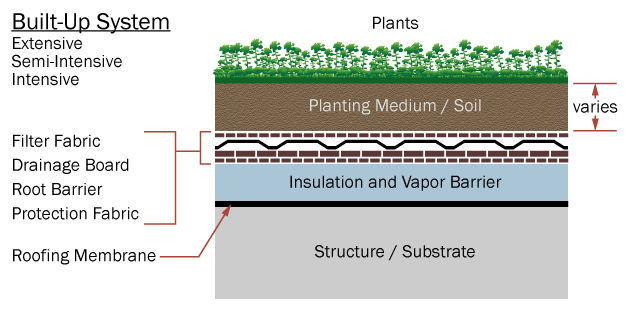This article provides an general overview of green roofs installed on buildings. We will provide a description of the three main types of green roofs: intensive, semi-intensive, and extensive. We also provide the benefits and a few things to watch out for when designing green roofs.
Green Roof Benefits
Heat islands, especially in urban areas, negatively affect microclimates by raising temperatures and altering air movement patterns. Heat islands are created by buildings and pavement that absorb sunlight during the day and release the energy as heat in the evening. The phenomenon leads to zones of higher temperatures around urban areas. We have attempted to address this by using high albedo (light colored) materials, but this simply reflects the radiant heat to other materials that can absorb it an release it in the evenings. The natural plantings and soils in green roofs mitigate the heat island effect by better modulating temperature fluctuations caused by radiant heating during the day. This leads to lower ambient temperatures in the microclimate surrounding buildings.
Green roofs can help reduce energy costs for a building by acting as another layer of insulation between the inside and outside of the roof. This is most noticeable in intensive green roofs since there is a thicker and more consistent layer of soil, which provides a higher insulating value. The insulating properties of the soil can also help reduce sound transmission through the roof from outside the building.
Perhaps the most important benefit of green roofs is that they can reduce the amount of and improve the quality of stormwater runoff from a building site. The soils of a green roof will capture a significant amount of stormwater, which is absorbed and used by the planted material. Any water that is released is done so at a slower and more consistent rate, which helps prevent flooding and runoff that can be destructive to the surrounding environment. The plants and soils also filter the stormwater, which helps clean it of pollutants that can negatively affect the natural surroundings. Many jurisdictions now require building owners to collect stormwater in infiltration basins that clean and slowly release the water back into the ground to help reduce the burden on the sewer systems - green roofs help do this naturally without the need for special infiltration basins or equipment.
While installing a green roof will not inherently qualify a project for LEED points, green roofs will contribute to achieving points in any number of categories including heat island effect reduction, storm water quantity and quality mitigation, and a reduction in energy usage.
One benefit of green roofs that is not easily quantifiable is the aesthetic improvement that landscape provides. This is especially important where building occupants overlook lower roof areas, which are often barren planes or are full of mechanical equipment. Simply providing planted areas on these low roofs will improve the appearance of the space, which may improve occupant mood and well-being.
Green Roof Considerations
There are a number of things to consider when designing for a green roof. One important item to design for is an increased structural load. This is especially true of intensive green roofs, which can have soil that is two feet deep or more. The structural engineer must factor in the weight of completely saturated soil since the plantings and the soil will hold a significant amount of water.
It is also important to factor in the type and lifetime of the roof membrane that will be used. Green roofs tend to improve the life of the roof membrane because it is completely covered by plantings and isn't exposed to the sun's harsh UV rays. However, the membrane may be exposed to plant roots, animals and insects, and fertilizer chemicals. It is important that a protective barrier be used over the waterproofing membrane.
Maintenance is also important to consider when designing a green roof. The owner should understand that a green roof requires routine landscape maintenance, which can vary from occasional to regular and can add a significant ongoing cost. In addition, space should be allocated for storage of maintenance materials. For instance, it may be inconvenient to take a lawnmower to the roof on a weekly basis if there is an area of grass that requires regular trimming.
Green Roof System Comparison
| EXTENSIVE | SEMI-INTENSIVE | INTENSIVE | |
|---|---|---|---|
| Plant Options | sedum, moss, grass | sedum, moss, grass, herbs, flowers, shrubs | sedum, moss, grass, large shrubs, trees |
| Soil Depth | 2" to 5" Deep | 5" to 8" Deep | 8" to 30"+ Deep |
| Dry Weight | 10 to 25 pounds dry weight | 25 to 40 pounds dry weight | 40 to 100+ pounds dry weight |
| System Types | Tray, Built-Up | Tray, Built-Up | Built-up |
| Maintenance | Minimal | Occasional / Routine | Routine |
| First Cost | Low | Medium | High |
Extensive Green Roofs
Extensive green roofs are generally made up of a very thin layer of soil or other planting medium with shallow-root plants like sedum, mosses, and grasses. The soil is usually not more than 5" deep and is sometimes contained by a tray system, which provides a barrier to excessive growth, protects the roof membrane, and also interlocks the entire system together to prevent wind damage. A more traditional planted roof of built-up layers is also common, but the tray system offers much more flexibility and comes pre-planted with mature specimens. Extensive systems weigh anywhere from 10 to 25 pounds per square foot when dry, which is why the interlocking system of trays is important - otherwise, strong winds could very easily blow the plantings away.

The biggest benefit of extensive green roofs is that they need very little maintenance. The plants, if chosen correctly for the climate, rarely need water so an irrigation system is not required. Fertilizers are also not required except in rare instances where weeds need to be controlled. All that is really needed is an occasional inspection to confirm that the trays are intact and that the plants are flourishing. Extensive roofs are also the cheapest to install and maintain.
Semi-Intensive Green Roofs
Semi-intensive green roofs require a deeper soil layer, but the payoff is in the types of plantings that can be used. In addition to the mosses, grasses, and sedum of extensive roofs, semi-intensive plantings include herbs, flowering plants, taller grasses, and small shrubs. Of course, this comes with a steeper price tag due to the additional weight and root barriers needed. Semi-intensive systems generally weigh between 25 and 40 pounds per square foot when dry. They are typically constructed in layers, but can also be installed using a tray system.

Semi-intensive green roofs require a bit more maintenance since the plants tend to need pruning, irrigation, and fertilization. If the roof is occupied, additional maintenance should be accounted for to make sure the roof is safe and comfortable. However, maintenance requirements are generally no more than would be expected for sidewalk planters.
Intensive Green Roofs
Intensive green roofs require the deepest soil and have the greatest impact on the structural design, but they also accommodate all types of plantings including large shrubs and trees. Intensive systems allow the designer to create a park-like setting so they are the best option for roof gardens that will be occupied. Intensive green roofs weigh from 35 pounds to beyond 100 pounds per square foot when dry - it is all a matter of the soil depth, which is affected by the amount of mounding that is used. Tray systems are not a viable option for intensive roofs due to the weight; therefor, a significant amount of attention must be paid to the various waterproofing and root barrier details.
Maintaining an intensive roof can be quite involved. Many plants will benefit greatly from an irrigation system especially if non-native vegetation is selected for its aesthetics. Larger plants will also require regular pruning and will have to be monitored for health. Intensive roofs are usually occupied so special attention needs to be paid to walkways and other occupied zones so that visitor safety is maintained.


